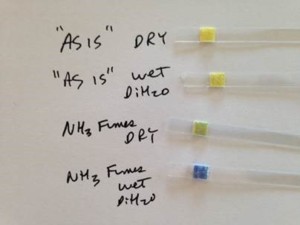
Yes, the cloths are reversible. As long as the cloth reverts back to the original goldenrod yellow color, it will continue to change when exposed to ammonia vapors. We aren’t certain of how many times it can be reused (it is somewhat dependent on the use). Eventually, it won’t revert back to its original color and can no longer be reused. It works best if exposed to vapors. If you get it wet, it will not be reusable.
Since the ammonia leak detection cloth is simply measuring pH, any interferences present that create an acidic or alkaline environment competing with the effect of any ammonia gas would interact with the cloth.
The ammonia 0-100ppm test strip technically has two test pads put together. One pad absorbs the dissolved ammonia and converts it to a gas, which the second pad registers and then changes color when dipped into an Ammonia solution.
We ran a test to see if it would work to detect ammonia gas. The short answer is yes, however, the color chart is not calibrated to the correct colors for this application.
The test was performed using 4 test strips:
- Strip 1 was left as is, dry.
- Strip 2 was dipped in DI water.
- Strip 3 was left dry and held over ammonia fumes from a bottle of cleaner for just a few seconds.
- Strip 4 was dipped in DI water, then held over ammonia fumes from a bottle of cleaner for just a few seconds.
The results of the test are shown below:

The dyes are not bound to the cloth with any special binders. They will wash out. They may also discolor materials they contact.
In this video, we created some example “chambers” to show how the Ammonia Leak Cloth detects ammonia gas leaks or how the Cobalt Chloride moisture detection paper can detect humidity. All of our leak detection products work similarly, and some are even reusable. For example, when the Ammonia Leak Cloth is moved away from the leak, it reverts back to the original golden yellow color and can be reused.
- The test strips are meant to detect ammonia and ammonium in water, but not combined ammonia compounds like chloramines.
- The test strip uses two pads in the test pad “sandwich” – the first pad creates an alkaline environment (pH > 11) which converts all of the ammonia/ammonium present to ammonia. The second pad employs a hydrophobic material and indicators to detect the ammonia present.
- The color chart is ppm as ammonia-nitrogen, not ammonia. There is sometimes confusion when comparing competing strips – some measure as ammonia-nitrogen (NH3-N), while others measure as ammonia (NH3). The 100 ppm as ammonia-nitrate is equivalent to 122 ppm as ammonia.
- The color charts were developed by creating ammonia standards from ammonium chloride (ACS grade). 0.19 grams is dissolved in 500 mLs of ammonia-free water. This is 100 ppm as ammonia-nitrogen. Serial dilutions produce the other standards.
The Ammonia Leak Detection Cloth is treated with a dilute ethanol solution of bromothymol blue and phenolphthalein (10:1 ratio) and air dried. When dry, the cloth is a yellow-orange color. When exposed to ammonia vapors, the indicator dyes turn the cloth blue/green due to the alkaline nature of the ammonia.
In air, the cloth reverses back to the yellow-orange color as it absorbs CO2 from the air. The carbonic acid lowers the pH and thus the indicator dyes revert back to their acidic color. This reversal can be accelerated if the cloth is placed in an acidic environment (say a vinegar/acetic acid atmosphere.)

